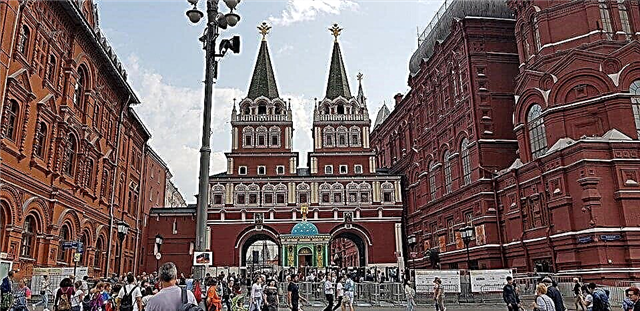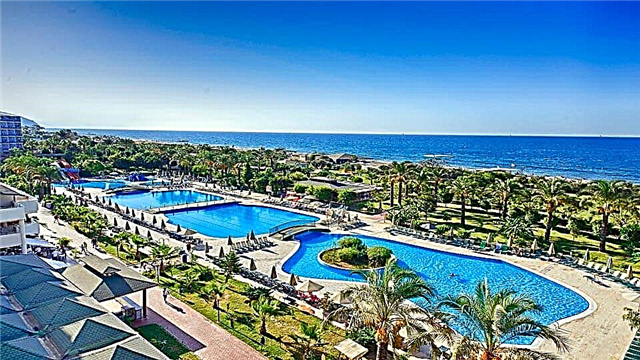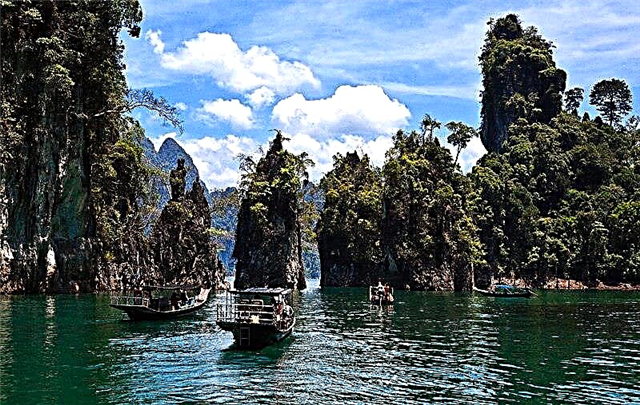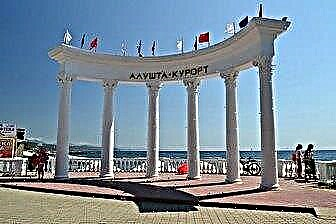Alushta is one of the key resorts in Crimea. The length of the coastline with beaches is several tens of kilometers, including the suburbs. This vast territory houses numerous hotels, sanatoriums, boarding houses, recreation centers and, as a legacy of the Soviet and post-Soviet era, an impressive private sector.
The city itself is a typical resort with a well-equipped embankment, restaurants and cafes for every budget, a water park and other entertainment. Separately, one can highlight the memorial house-museums of famous cultural figures, several mansions of the early XX century, the Gothic church of all Crimean saints and the ruins of ancient fortresses.
The main beauties are located outside the city - these are mountain ranges with deep caves, protected areas and picturesque valleys.

Apartments and hotels at affordable prices.
from 500 rubles / day
What to see and where to go in Alushta?
The most interesting and beautiful places for walking. Photos and a short description.
Alushta embankment
Alushta embankment is perhaps the first place where guests of the city go, since the alley is the center of resort life and a place where you can take a leisurely stroll in the shade of the coastal park. In the heart of the promenade there is a rotunda with the name of the city - a stop for photographs and observations of the sea surface. ND Stakheev, a merchant and gold miner, who was the nephew of the artist I.I.Shishkin, took part in the design of the embankment.

Professor's Corner
Professors Corner is a coastal area with several beaches and the surrounding area, located in the western part of the city. The length of the coastline in this place is about 2.5 km. All the necessary infrastructure has been created for tourists: cafes, entertainment, attractions, beauty salons, shops, a water park. There are also many hotels and private boarding houses.

Dolphinarium "Aquarelle"
An entertainment center for the whole family, opened in 2013. Bottlenose dolphins and seals perform for tourists. The large hall of the dolphinarium is designed for 700 people, where performances are performed. In the small room, animals rest and undergo rehabilitation. The institution also offers dolphin therapy services, which helps with many diseases of a neurological nature.

Alushta aquarium
This place appeared thanks to the expansion and development of the fish exhibition of the Azov and Black Seas, which took place in 2003. By 2007, the collection of marine life had grown so much that it became the largest on the Crimean coast and throughout Ukraine. Today, the live exhibition is located in 4 halls, in addition to fish, it contains corals and shells. A sea cow, a dog, a horse, a dragon and a cat live here.

Park "Crimea in miniature"
Several cities of the peninsula have their own "Crimea in miniature", where the main attractions are presented on a reduced scale. One of them is located in Alushta. Here tourists will see copies of "Swallow's Nest", Vorontsov Palace, Simferopol Kenassa, Funa Fortress and other interesting places located in Yalta, Feodosia, Sevastopol, Simferopol, Bakhchisarai, Sudak and Evpatoria.

Almond Grove Water Park
Almond Grove is not just a water park, but a full-fledged resort complex with hotels, villas, a beach, restaurants, entertainment, a walking area decorated with palm trees and exotic flowers. The water entertainment area has 11 slides, 6 swimming pools, artificial waterfalls, a jacuzzi and children's playgrounds. For guests staying in the hotels of the complex, the entrance to the water park is free.

Temple in the name of all Crimean saints
The church was erected in the middle of the 19th century according to the plan of the architect from Odessa G. Toricelli. Construction work was carried out with public funds. The architecture of the building is very different from the appearance of the Orthodox churches in Crimea. When drawing up the project, English rural churches were taken as a basis. At that time, the Gothic style was in vogue in Russia, so the appearance of the building was made taking into account its canons.

Cosmo-Damianovsky Monastery
The abode is located on the territory of the Crimean Nature Reserve, surrounded by the peaks of the Babugan-Yaila massif. It was founded in 1856, but already in 1898 it was closed due to the inappropriate behavior of monks who became addicted to drunkenness and debauchery. After a short time, the monastery was reopened, but already as a female one. During the Second World War, the complex of buildings was destroyed, only a small chapel over the holy spring has survived. The revival began in 1994.

Temple-lighthouse of Nicholas the Wonderworker
The church is located in the village of Malorechenskoye and is the highest church on the peninsula. The building is considered part of the memorial complex dedicated to those who died on the rivers and seas. The building was erected in 2007 according to the project of A.V. Gaidmak in the neo-Byzantine style. In architectural terms, it is a narrow tower, into which entrances decorated with classical porticos lead from all sides.

Alushta Museum of History and Local Lore
The museum exhibition opened in 1923. Since then, it has been closed three times, but since 1971 it has been operating continuously. The museum is located within the Seaside Park in the historic Modern mansion of the early 20th century. The name of the building already speaks for itself. The fund is based on exhibits collected with the help of the residents of Alushta, which are associated with history, ethnography and archeology.

House-Museum of Ivan Shmelev
I.S.Shmelev is a writer famous for covering the events of the first Russian revolution in his works. In Alushta, he lived in the period 1918-1922 - a rather difficult time of the Civil War. The house in which the author spent four years is located on the territory of the Professorsky Corner district. It was turned into a museum in 1993. It is a small adobe building in a classic style with large windows, a bright veranda and two rooms.

Museum-Estate of A. N. Beketov
The museum is located in the western part of the city, being the cultural center of the entire Professor's Corner. The mansion, where the collections are located, is made in the original architectural style with Moorish notes. It was erected in 1896 according to the project of A. Beketov, an artist and an architect, as a summer residence for family vacations. It has survived to this day in its original form.

House-Museum of S. Sergeev-Tsensky
The collection of the museum is dedicated to the life and work of S. Sergeev-Tsensky, a Russian and Soviet writer who spent quite a lot of time in Alushta - from 1906 to 1941 and from 1946 to 1958 until his death. After the end of the Second World War, he himself was engaged in the restoration of his home and garden, destroyed by the German invaders. The exposition consists of archival documents, manuscripts, books and personal belongings of the writer.

Princess Gagarina's palace
A picturesque building of the early XX century, erected in an eclectic manner with elements of the Romanesque style, designed by N. P. Krasnov for Princess A. Gagarina. Bavarian castles located in the Alps were taken as a model. Most of the materials for construction were delivered from abroad - Italy, France, Germany. Nowadays, the building of the Utes sanatorium is located on the territory of the mansion.

Dacha of the merchant Stakheev
The mansion is located in the central part of Alushta. The building was erected in the 19th century according to the project of N. Krasnov (his most famous creation is the Livadia Palace). The architectural style can be defined as a mixture of European Classicism and Art Nouveau. Before the revolution, the mansion was a favorite meeting place for the visiting elite. After 1917, the house was given over to the needs of the children's creativity center.Thanks to this, it was not destroyed, and it has survived to this day in excellent condition.

Dacha Dove
Mansion built in 1887, located in the city center. It is famous for the fact that in 1894 Tsarevich Nikolai Alexandrovich and his future wife, Princess Alice of Hesse-Darmstadt, met here. During the Civil War, the basements of the building were used to contain rioters and White Guards. Today the dacha is occupied by the S.N.Sergeev-Tsensky Library.

Karasan Palace
The palace and park ensemble, founded in 1820 by A.M. Borozdin - senator and civil governor of Taurida. The architecture of the main building is a bizarre mixture of different styles with a clear Moorish dominance, as evidenced by the shape of the windows and stucco ornaments. Since 1924 the sanatorium "Karasan" was located here, which became famous throughout the Soviet Union.

Fortress Aluston
Ruins of a 6th century defensive structure. The fortress was built under the Byzantine emperor Justinian I, in the 7th century it came under the control of the Khazar Kaganate, but after the decline of this kingdom it was abandoned. In the XIV century, under the Genoese Republic of Aluston, a second line of defensive walls was revived and erected. In 1475 the fortress was destroyed by Turkish troops. Since then, the stronghold has been in ruins (in the 19th century, there was still a light restoration).

Funa fortress
Fortification of the XIV-XV centuries at the foot of South Demerdzhi. In the Middle Ages, a trade route passed through it, connecting Aluston with the steppe Crimea. The fortress was erected by the Genoese to protect their possessions. By 1459, Funa had turned from a small military garrison into a full-fledged castle. In 1475, during the attack of the Ottoman Turks, the complex was destroyed and was never rebuilt.

Mount Castel
A small peak 439 meters high, located in the south of Alushta. By its geological nature, Castel is an "underdeveloped volcano" (laccolith), the formation of which stopped at a certain stage. In the bowels of the mountain there is a core of solidified magma. Once upon a time, there was a fortress at the top, which, according to legend, served as the last refuge of Princess Theodora of Sugdei, who ruled these lands before the arrival of the Genoese.

Crimean natural reserve
The largest nature reserve on the peninsula, founded in 1991. It covers an area of more than 44 thousand hectares, most of which belongs to the mountain-forest zone. Tourists can visit one of the many hiking trails, the local trout farm, Lake Uch-Kosh, the Cosmo-Damianovsky Monastery and other attractions located within the protected area.

Jur-Jur waterfall
Dzhur-Dzhur is the most picturesque and full-flowing waterfall of the peninsula; it does not dry out even in the hottest weather. Its name is quite recognizable, as it appears in many excursion booklets. The stream is located within the Alushta region in the Khapkhal gorge at an altitude of 468 meters. The drop height of the jets is 15 meters. During the season, the waterfall is always crowded, as it is one of the most popular natural attractions.

Stone mushrooms in the valley of Sotera
Stone mushrooms are rock formations with a wide head on a clay foot, formed as a result of long-term natural processes. Instances located in the Sotera Valley have a height of 3.5 to 6 meters and a base diameter of up to 2.5 meters. Until 1983 there were only three of them, but in 1999 new ones began to grow. This phenomenon confirms the fact that Crimea is a fairly young territory by geological standards.

Mount Demerdzhi and the Valley of Ghosts
The peak of Demerdzhi is one of the most popular on the peninsula among lovers of hiking trails. For many tourists, visiting this place is a must on the program, especially since it is covered with mysterious legends. The famous Valley of the Ghosts is located near the mountain, which is a heap of boulders and rocks of a very bizarre shape. In the rays of sunset, strange shadows-ghosts wander among the stone masses, fascinating and at the same time frightening.

Chatyr-Dag caves
The Chatyr-Dag mountain range is part of the Crimean Mountains. It is located about 10 km from the coast and consists of two plateaus - upper and lower. The highest point of the ridge is the Eklizi-Burun peak. Due to the structure of relatively young rocks, several caves have formed within the massif: Emine-Bair-Koba, Emine-Bair-Khosar, Suuk-Koba, Bin-Bash-Koba and Mramornaya, which tourists visit with pleasure.












